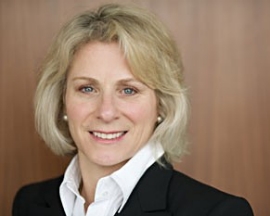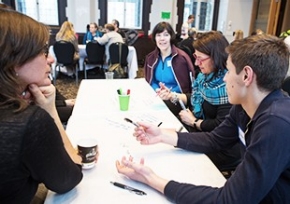In January 2011, a strategic planning process was formally launched under the name “Project Next.” Cannon says branding the process was a powerful way to engage people across the campus in imagining the university’s future.
The process resulted in a new five-year strategic direction, Eyes High, developed in consultation with students, faculty, staff, alumni and leaders in the city of Calgary. Eyes High articulates a vision for the University of Calgary to become “one of Canada’s top five research universities, grounded in innovative learning and teaching and fully integrated with the community of Calgary, by the university’s 50th anniversary in 2016.”
We spoke to Cannon in advance of “How can universities go from good to great?,” her March 10 presentation at Concordia.
How would you characterize the state of the University of Calgary when you assumed your role in 2010? What were the first important steps you took to generate a sense of direction and momentum?
Cannon: Back in 2010, the University of Calgary certainly had some successes under its belt and some momentum. As a young university, it had grown very quickly and had some challenges with respect to systems and processes and the level of sophistication that is needed to support a very large and complex organization.
We did not have clarity of direction and vision, despite having a lot of good things happen. We had not set collective goals for what we wanted the university to be in the future. For me, this provided an opportunity to turn a page and get people thinking about the future.
During the first two to three months, I spent time listening in small groups, holding town halls, getting out in front of students, faculty and staff so they could see me as the president and not as a dean of one of the Faculties. I was speaking to people about imagining a new future for the university — one that would allow us to capture real opportunities — and this set the stage for our strategic planning process.
You’ve set a high bar for the University of Calgary. How important are stretch goals? How do you know when you’ve tried to stretch too far, or not stretched far enough?
Cannon: One of the reasons we did a five-year strategic plan was in part to align it with an important milestone. We asked ourselves, “When we turn 50 in 2016, what do we want to look like?” I wanted to create a sense of urgency on campus. A lot needed to be done, so this spoke to creating a timeframe for the plan.
I thought we were ready to take a step up and the institution was ready. Eyes High came from the bottom up; I did not drive the strategy development day by day. When the working group came back with the words, “We will be the top research university in Canada,” that did not get people get excited; it wasn’t bold enough. So the team came back with analysis and said, “In five years, how far can we get? “We want to be the top six in 2016,” which also did not sound very good. So, again, our staff, students and faculty came back and said they wanted us to be among the top five research universities by 2016.
It is a stretch goal, but it is not so far out of this world. We know it is achievable, but it is going to take a lot of work. People may say, “Okay, you are getting close to 2016, but what if you don’t get there?” I ask this question back to our students, faculty and staff, and our community as a whole.
What we want people to say in 2016 is that it would be great to be among the top five — and we are already the top five in many areas — but we want people to say this place is different, it is better, we are aiming higher, we have achieved levels of excellence. They have to know that they are on a journey to being among the top five.
How do you cultivate and foster a climate that invites people to excel?
Cannon: I think you need to translate the strategy into action. It is the biggest compliment when I walk around campus and a faculty or staff member says, “Things feel different on campus.” I know then that they understand Eyes High. The strategy is bigger than themselves. It becomes a call to action.
I also tell people we all have to show up on campus, every day, with a commitment to excellence — no matter our job. We put a lot of time into delivering a strategy in a tangible way. Building a strong campus culture is the enabler to deliver this strategy. If people do not feel pride in their organization, they will not strive for excellence. That is what we are working very hard to create.


 Elizabeth Cannon, president of the University of Calgary, comes to Concordia on March 10.
Elizabeth Cannon, president of the University of Calgary, comes to Concordia on March 10.
 The question “What’s next for Concordia?” has been actively discussed at a series of Idea Cafés.
The question “What’s next for Concordia?” has been actively discussed at a series of Idea Cafés.